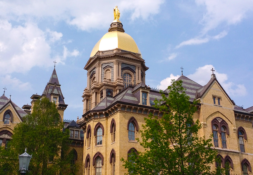“Freedom OF religion cannot coexist with freedom FROM religion,” declared Archbishop Charles J. Chaput at the August 2011 World Youth Day in Madrid, Spain. His words cut to the heart of what it means to be a Catholic in modern day society, in which religious freedom is compromised by both societal pressures and governmental authority. He highlights the media’s important role, for good or for ill, in the process of secularization.
Religious freedom is a fundamental right, yet the practice of religious freedom is increasingly limited in the public sphere. The narrow religious exemptions and conscience provisions of the recent healthcare mandate, which require employers to provide insurance coverage for contraceptives services and certain abortifacients for their employees, are one example of limitations placed on religious freedom. For a forthright examination of the mandate’s flaws and the context in which it has developed, see Bishop Kevin C. Rhoades’ recent Red Mass homily (page 1).
Archbishop Chaput provides helpful insight into understanding religious freedom. “First, ‘freedom of religion’ presumes that people have free will as part of their basic human dignity,” he said. “Second, ‘freedom of religion’ presumes that questions about God, eternity and the purpose of human life really do have vital importance for human happiness. And therefore people should have the freedom to pursue and to live out the answers they find to those basic questions without government interference.”
Fr. Richard John Neuhaus articulates the results of expelling religion from society in his book, THE NAKED PUBLIC SQUARE: RELIGION AND DEMOCRACY IN AMERICA.” He writes, “When religion in any traditional or recognizable form is excluded from the public square, it does not mean that the public square is in fact naked…the vacuum will be filled by ERSATZ religion, by religion bootlegged into public space under other names.” Fr. Neuhaus argues that society needs a firmer foundation than shallow notions of equality. Lacking such, it adopts instead a kind of “religion” of tolerance grounded in moral relativism.
Archbishop Chaput echoes Fr. Neuhaus’ argument: “Forcing religious faith out of a nation’s public square and out of a country’s public debates does NOT serve democracy. It doesn’t serve real tolerance or pluralism. What it DOES do is impose a kind of unofficial state atheism. To put it another way, if we ban Christian Churches or other religious communities from taking an active role in our nation’s civic life, we’re really just enforcing a new kind of state-sponsored intolerance—a religion without God.”
Inaccurate treatment of religion in the media is both a cause and an effect of secularization. Studies from groups like the Pew Center for the Public and the Press have shown that a disproportionate percentage of journalists are left-leaning, and much of what passes for serious journalism fails to describe religious affairs seriously.
Last month, for example, the NEW YORK TIMES’ coverage of Pope Benedict’s trip to Germany emphasized the large crowds and counter-demonstrations but fails to report the substance of his address. What did the NYT use for a photo of the event? The back of Pope Benedict’s head.
The mainstream media coverage of the March for Life, the annual pro-life demonstration in Washington D.C., has been so deficient as to be comical. Rick Sanchez of CNN was unable to figure out who was marching: “It’s the 37th anniversary of the Supreme Court’s decision in ROE V. WADE case….both sides being represented today, but it does appear to me, as I look at these signs that – which side is represented the most….Do we know?” Apparently Sanchez didn’t. In addition, the media favors terms with more negative connotations like “anti-abortion” or “anti-choice” while adopting its counterpart’s preferred moniker, “pro-choice.”
Even at a Catholic university, misconceptions in media persist. The OBSERVER’S September 30 editorial responding to University President Fr. John I. Jenkins’ letter to Kathleen Sebelius, head of the US Department of Health and Human Services, urges the university to decide between a primarily research-oriented or religious focus. One example the OBSERVER used to support its claim that “[r]ecent trends suggest education takes precedence over religion” at Notre Dame is the fact that “[f]aculty, staff and students are encouraged to seek the truth in whatever form it takes, including that of scientific research.” This claim presents a false dichotomy that denies both the Catholic vision of the authentic nature of a university and, ultimately, the unitive nature of truth. Recognizing the complementarity of faith and reason, a truly Catholic vision of reality embraces the truth as it is approached in all fields of study.
In his World Youth Day address, Archbishop Chaput holds out the hope that secularization can be arrested by a resurgence of media that takes religion seriously. Though members of the media need not be believers themselves, their profession demands intellectual honesty. An important part of this honesty is the ability to recognize and to seek to understand the fundamental assumptions that guide human action – even if that assumption is that all values are equal.
Stephanie House is a senior who is sad to leave ND in May. Contact her at shouse1@nd.edu.
Claire Gillen is a senior history major and, unlike Jonathan Liedl, an unabashed INTJ. Contact her at cgillen2@nd.edu.

